.
Material: Polychrome breached marble, identifiable with high probability as Giallo di Sicilia
Technique: All-round sculpture on monolithic block
Height: [insert size]
Estimated weight: [insert if detectible]
Proposed era: XII–XIII century
Stylistic scope: Southern Romanesque, with plausible attribution to the Federian context (Svevanian Italy, Sicily or Campania)
Origin: [not declared / to be integrated]
Inscription: Engraved acronym "S.C.P." (not contemporary, probable modern intervention)
⸻
I. GENERAL STATE OF CONSERVATION
• Structure: Integrates into the general volume. No compromising fractures, presence of ancient structural microlesions and visible consolidations.
• Stability: Good. The base appears flat and regular; the object is well balanced and free of obvious points of effort.
• Material: High-density, compact and visibly antique breezed marble. The polychrome pattern and the presence of ferrous veins suggest identification with western varieties of the Giallo di Sicilia (probably originating from historical quarries in Segesta, Trapani, or neighbouring areas).
⸻
II. FORMAL-STYLISTIC ANALYSIS
A. Subject
Male figure kneeling, in an act of support - classic iconography of the stylofori or liturgical telamoni, common in religious architectural areas (pulpits, amboni, portals, cibori).
B. Anatomy
• Face: Expressive, tragic, with contracted and asymmetrical features. Beard and hair sculpted in deep, irregular strands. Eyes hollow but not perforated - Romanesque technique.
• Arms and hands: Volumetric simplification, squared fingers, sculpted with manual gorb, without realistic anatomy.
• Legs: Kneeling position, with advanced right knee and retroflexed foot; moulded to full mass, with archaic plastic definition.
C. Clothing
• Short tunic, rendered through geometric and rudimentary modelling. Paneling made for masses, without naturalistic folds or gothic movement.
• No liturgical decoration or frieze. Functional, non-celebrative garment - consistent with iconography of sacred servitude or symbolic support of divine law.
⸻
III MATERIAL ANALYSIS
A. Lithological type
• Polychrome brecciated marble, high density and heterogeneous grain.
• Presence of ochre shades, intense yellow, iron red and brown, with gray-blackish veins. Irregular but natural pattern.
• Excluding the origin of Apulian quarries (Trani, Apricena, Lecce) for colour, weaving and reaction to light.
• High compatibility with Giallo Antico di Segesta, Breccia di Aspra or reused late-ancient Trapani marble.
B. Surface
• Burnished natural patina, layered in depressions and furrows.
• Widespread micro-cavillature from thermal and atmospheric ageing.
• Presence of mineralised organic black crusts, compatible with liturgical or hypogeal environments.
• No signs of modern abrasion or industrial polishing. Absence of waxes or simulated ancient paints.
⸻
IV. PROCESSING AND TOOLS
• Obvious traces of manual gorbia with uneven, oriented and asymmetrical cuts.
• Surfaces worked on inclined planes (typical of the Romanesque), with sharp but unfinished recesses.
• Absence of milling, disc abrasions, mechanical tools → authenticity of manual execution confirmed.
• The lower surfaces also show flat chisel processing, with visible and natural path.
⸻
V. ALTERATIONS, RESTORATIONS AND REGISTRATION
• Ancient fractures stabilised in the back area of the garment, on the edge of the seat, and at the base.
• Probable non-invasive historical grouting in at least two places (left and back margin).
• Engraving "S.C.P." on the back not compatible with the mediaeval period by type of sign and depth: probable recent mark (archiving, restoration, or private origin).
⸻
VI. STYLISTIC CONTEXT AND ATTRIBUTION
• The treatment of the masses, the iconographic simplification, the aniconicity of the clothes and the load-bearing function make the work compatible with Romanesque-southernal productions of the 12th and 13th centuries.
• The use of polychrome yellow marble and the hieratic posture suggest a Sicilian or Campanian liturgical context, in line with the Federician environment (1210–1250).
• Possible references: stylophons of Monreale, carved portals of Troy, kneeling figures in Swabian architectural environments of Bitonto and Cimitile.
⸻
VII Conclusion
The work analysed is presented as an authentic mediaeval stylist, made of Sicilian brecciated marble, and referable with stylistic and material coherence to the Romanesque-Federician context of southern Italy, probably western Sicily, XII-XIII century.
No elements have been detected that indicate a modern or revivalist production. The executive quality and iconographic coherence make it an example of high historical and museum value.II. ANALISI FORMAL-STILISTICA
A. Soggetto
Figura maschile inginocchiata, in atto di sostegno – iconografia classica degli stilofori o telamoni liturgici, comuni in ambiti architettonici religiosi (pulpiti, amboni, portali, cibori).
B. Anatomia
• Volto: Espressivo, tragico, con tratti contratti e asimmetrici. Barba e capelli scolpiti a ciocche profonde, irregolari. Occhi incavati ma non traforati – tecnica romanica.
• Braccia e mani: Semplificazione volumetrica, dita squadrate, scolpite con sgorbia manuale, senza anatomia realistica.
• Gambe: Posizione inginocchiata, con ginocchio destro avanzato e piede retroflesso; modellate a massa piena, con definizione plastica arcaica.
C. Vestiario
• Tunica corta, resa mediante una modellazione geometrica e rudimentale. Panneggio reso per masse, senza pieghe naturalistiche o movimento gotico.
• Nessuna decorazione liturgica o fregio. Indumento funzionale, non celebrativo – coerente con iconografia di servitù sacra o sostegno simbolico della legge divina.
⸻
III. ANALISI MATERICA
A. Tipologia litologica
• Marmo brecciato policromo, ad alta densità e grana eterogenea.
• Presenza di tonalità ocra, giallo intenso, rosso ferruginoso e bruno, con vene grigio-nerastre. Pattern irregolare ma naturale.
• Esclusa la provenienza da cave pugliesi (Trani, Apricena, Lecce) per colore, tessitura e reazione alla luce.
• Alta compatibilità con Giallo Antico di Segesta, Breccia di Aspra o marmo trapanese tardo-antico riutilizzato.
B. Superficie
• Patina naturale brunita, stratificata in depressioni e solchi.
• Diffusa microcavillatura da invecchiamento termico e atmosferico.
• Presenza di croste nere organiche mineralizzate, compatibili con ambienti liturgici o ipogei.
• Nessun segno di abrasione moderna o lucidatura industriale. Assenza di cere o vernici antiche simulate.
⸻
IV. LAVORAZIONE E UTENSILI
• Tracce evidenti di sgorbia manuale con tagli disomogenei, orientati e asimmetrici.
• Superfici lavorate a piani inclinati (tipico del romanico), con incavi netti ma non rifiniti.
• Assenza di fresature, abrasioni a disco, utensili meccanici → autenticità dell’esecuzione manuale confermata.
• Le superfici inferiori mostrano anche lavorazione a scalpello piano, con tracciato visibile e naturale.
⸻
V. ALTERAZIONI, RESTAURI E ISCRIZIONE
• Fratture antiche stabilizzate nella zona posteriore del capo, sul bordo del piano di seduta, e alla base.
• Probabile stuccatura storica non invasiva in almeno due punti (margine sinistro e retro).
• Incisione “S.C.P.” sul lato posteriore non compatibile con il periodo medievale per tipologia di segno e profondità: probabile marchio recente (archiviazione, restauro, o provenienza privata).
⸻
VI. CONTESTO STILISTICO E ATTRIBUZIONE
• Il trattamento delle masse, la semplificazione iconografica, l’aniconicità delle vesti e la funzione portante rendono l’opera compatibile con produzioni romanico-meridionali del XII-XIII secolo.
• L’uso del marmo giallo policromo e la postura ieratica suggeriscono un contesto liturgico siciliano o campano, in asse con l’ambiente federiciano (1210–1250).
• Possibili riferimenti: stilofori di Monreale, portali scolpiti di Troia, figure inginocchiate in ambienti architettonici svevi di Bitonto e Cimitile.
⸻
VII. CONCLUSIONE
L’opera analizzata si presenta come stiloforo medievale autentico, realizzato in marmo brecciato siciliano, e riferibile con coerenza stilistica e materica all’ambito romanico-federiciano dell’Italia meridionale, verosimilmente Sicilia occidentale, XII–XIII secolo.
Non sono stati rilevati elementi che indichino una produzione moderna o revivalistica. La qualità esecutiva e la coerenza iconografica la rendono un esemplare di alto valore storico e museale.


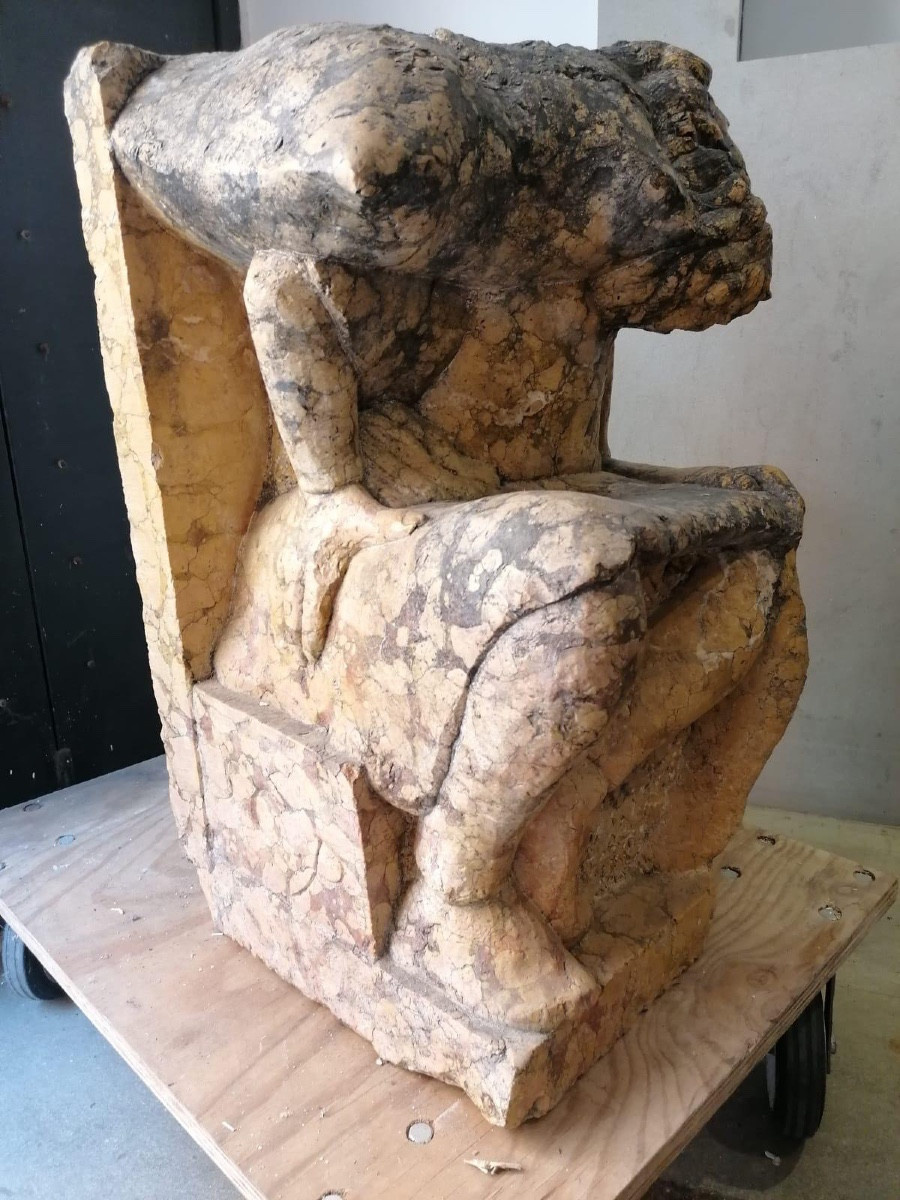









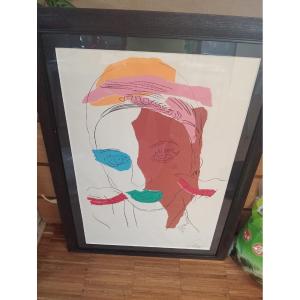

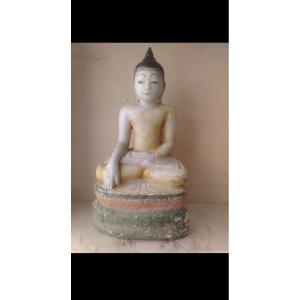



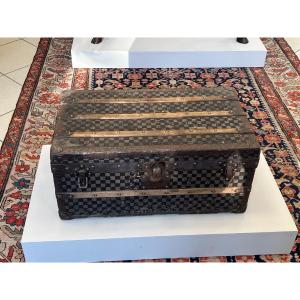
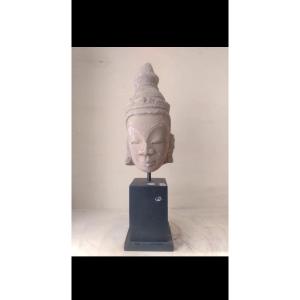



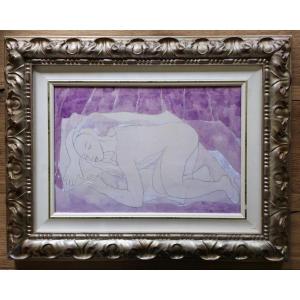

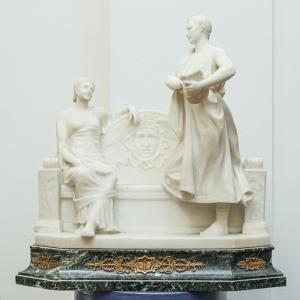







 Le Magazine de PROANTIC
Le Magazine de PROANTIC TRÉSORS Magazine
TRÉSORS Magazine Rivista Artiquariato
Rivista Artiquariato